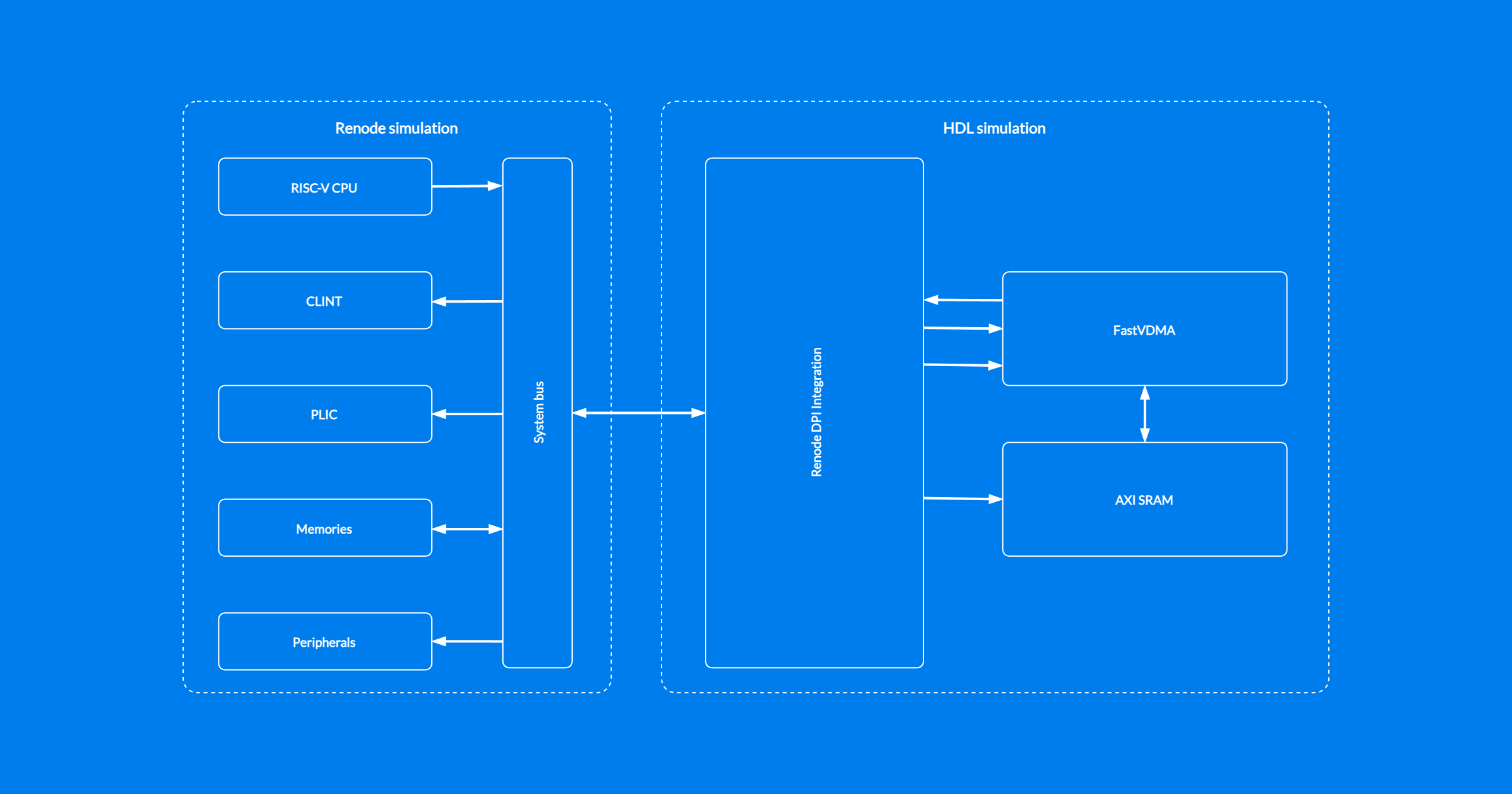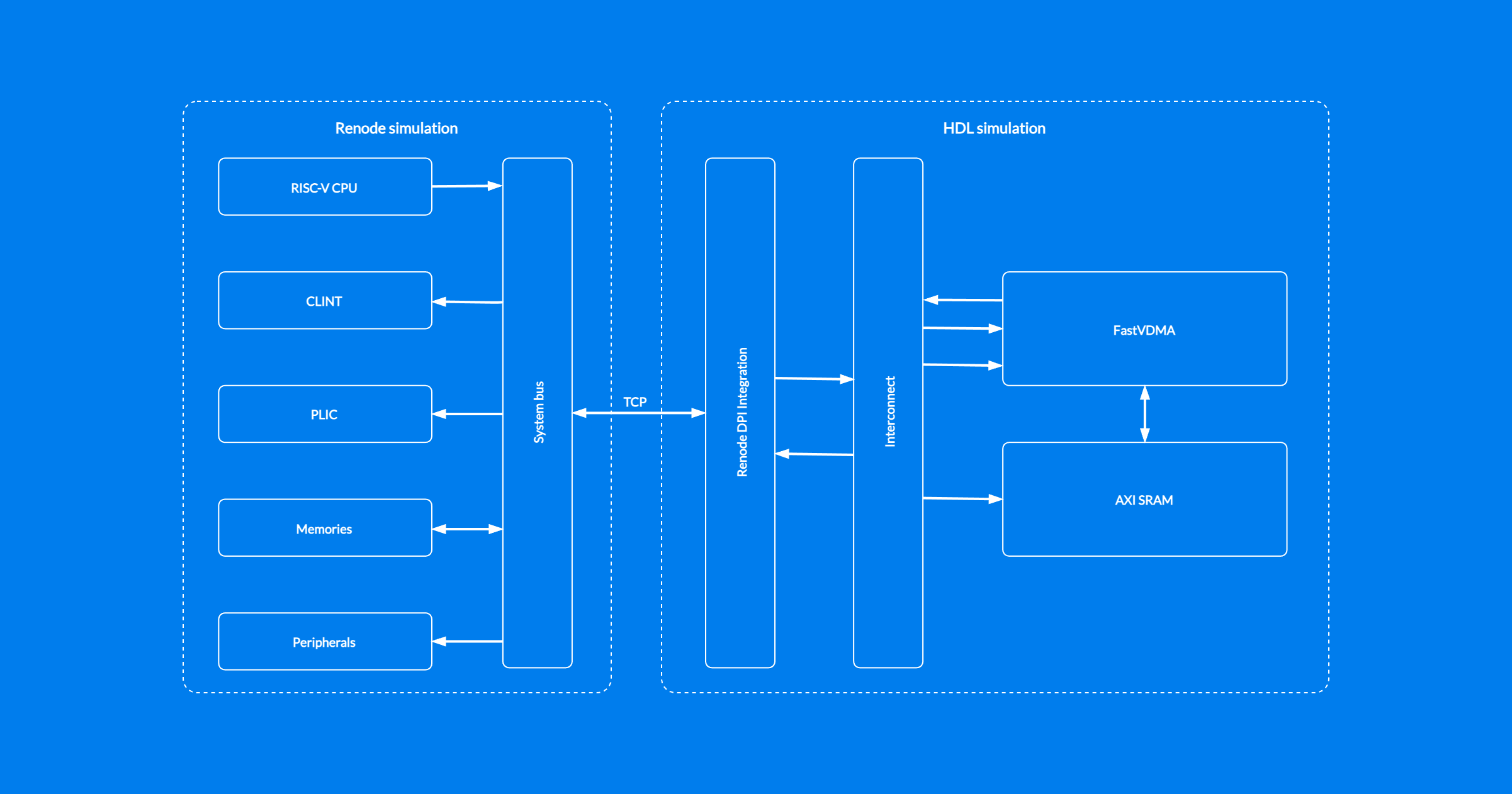When developing complex FPGA designs and custom SoCs, simulating and testing HDL designs in a larger context is necessary to accurately replicate real use cases. For fast iteration, you can combine cycle-accurate RTL simulation of elements of your design undergoing most heavy modifications with functional simulation using Antmicro’s Renode framework for “best of both worlds” in terms of performance vs. accuracy.
Renode’s HDL co-simulation ecosystem includes support for SystemVerilog DPI (Direct Programming Interface), which provides integration with a wide range of popular tools such as Verilator, Questa and VCS. In this article we summarize DPI support in Renode and describe new co-simulation features in two setups: with a virtualized interconnect and with an HDL interconnect. These new capabilities were developed partly within the European Union’s TRISTAN project, which focuses on providing open IP and development ecosystem for RISC-V projects.

DPI support in Renode
Co-simulation is especially useful in pre-silicon development projects or in FPGA SoC-based product development, bridging the gap between software and digital design engineers, allowing them to work in a single environment and co-develop hardware and software features of a product. A standardized interface like DPI can cater for both use cases and work across the multiple simulator ecosystems, both open and proprietary.
It’s only natural that the support for DPI in Renode was developed in collaboration with Microchip in the context of their RISC-V based PolarFire SoC FPGA, whose roll-out was supported by Renode even before silicon was generally available.
Currently Renode supports the following bus implementations via the DPI interface:
- AXI4
- AXI4Lite
- APB3
- AHB
To showcase different DPI-based co-simulation scenarios in Renode, we have a renode-dpi-examples repository containing a CI configured to build and run the samples in Verilator.
Historically, Renode supported scenarios with a single range of the memory map (e.g. a single peripheral) forwarded to a single instance of a co-simulation tool, and while it was possible to have multiple peripheral instances, creating blocks that are separate on a bus but connected to a single co-simulation tool instance was harder and less scalable than we’d like. With our recent efforts around co-simulation in Renode focused on extending the DPI support to enable more complex co-simulation scenarios, we provide new abstractions to simplify this process, in two flavors: including an interconnect or with a virtualized interconnect.
Virtualized interconnect
In a virtualized interconnect setup, RTL peripheral modules are connected directly to the Renode DPI integration layer through bus protocol adapters. Transactions are passed directly to Renode, using absolute addresses as defined in Renode platform description. Effectively, the job of directing a transaction to/from a particular peripheral, which is normally performed by an interconnect inside the RTL simulation, is outsourced to Renode.

While this approach represents a simplification of the actual system, it provides several benefits: compared to a setup with the interconnect as part of HDL simulation, it is conceptually simpler, doesn’t require you to provide the interconnect IP and is less compute-intensive.
You can find an example scenario with two AXI managers and two AHB subordinates connected directly to Renode using a virtualized interconnect in the renode-dpi-examples repository.
Interconnect as part of HDL simulation
An alternative approach relies on using actual interconnect RTL which has to be provided by the user. Although this setup is more complex compared to a virtualized interconnect, it offers better accuracy of the simulation and the possibility to include various interconnect features, such as request arbitration and prioritization.

To use the interconnect RTL, you need to include its implementation and correctly configure it to ensure proper routing between connected blocks.
An example scenario based on AXI interconnect RTL is also available in the renode-dpi-examples repository.
DPI-based HDL co-simulation in Renode for accelerated FPGA and ASIC design
Renode’s co-simulation support, which also includes integration with SystemC, can help you accelerate complex hardware-software co-development and testing in a flexible, deterministic environment.
Whether your use case involves pre-silicon development for complex ASICs involving internal management SoCs, or co-developing FPGA SoC IP and drivers, you can most likely benefit from Renode’s comprehensive simulation features. Reach out to us at contact@antmicro.com and take a deeper dive into Antmicro’s development services and the Renode methodology.



